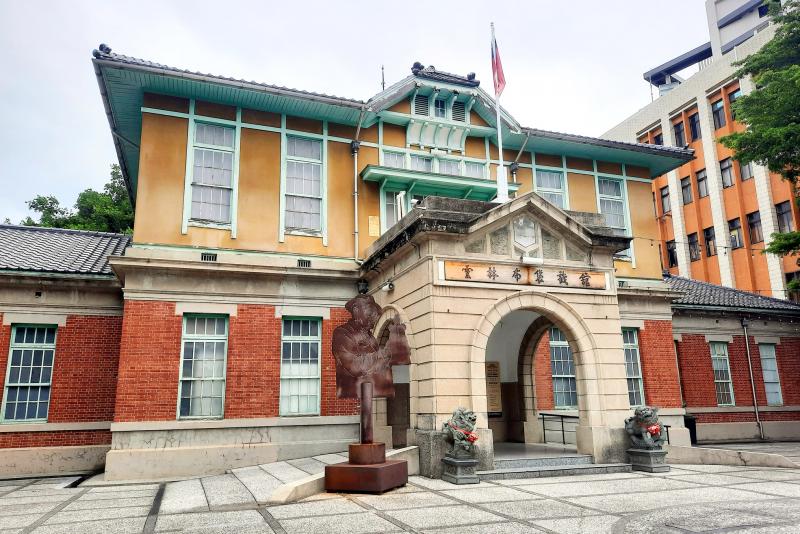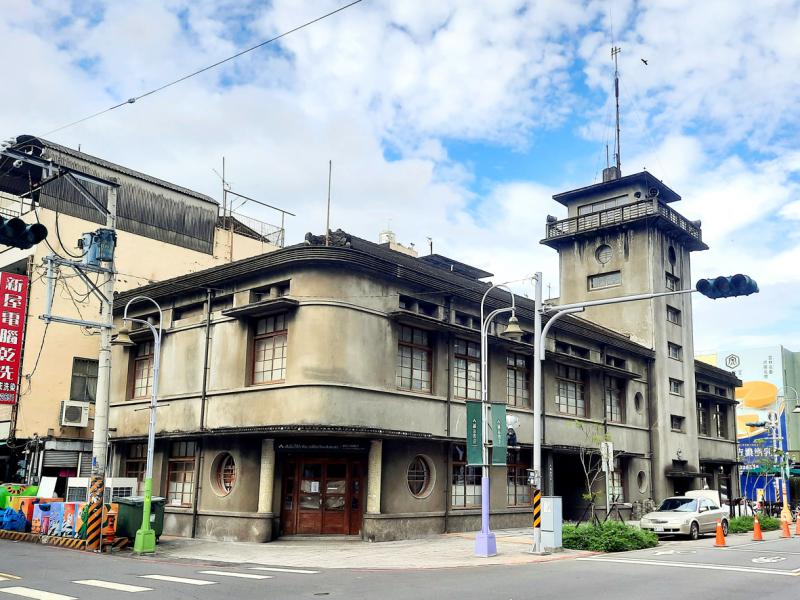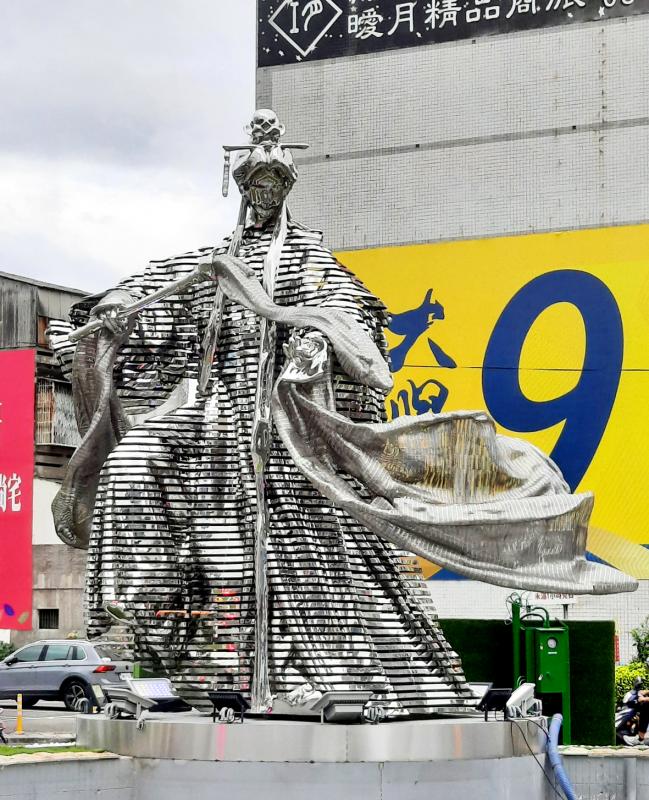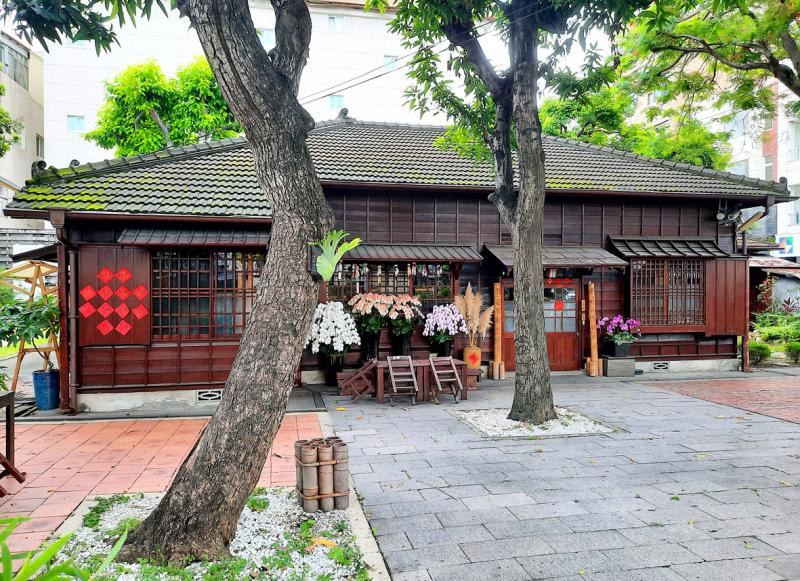To the consternation of its biological father — China — the young nation of Taiwan seems to prefer its step-dad, Japan.
When the latter was forced out, a semi-modernized iteration of the former returned. And just as some people thrive as adults, despite an unstable childhood, Taiwan has become a democratic success. Unfortunately, the island’s biological father behaves like a parent who is no use, yet who continues to meddle.
A combination of rose-tinted retrospection and growing mutual respect has given many Taiwanese a highly positive attitude toward Japan. Physical reminders of the 1895-1945 period of Japanese rule are treasured, especially in towns like Huwei (虎尾) where — it’s not difficult to argue — Tokyo’s efforts to organize the island’s economy for the benefit of Japanese corporations and consumers brought noticeable local progress.

Photo: Steven Crook
Huwei is in the very center of Yunlin County, and in recent decades this location has brought it a few advantages. The county’s high-speed railway station is northwest of the downtown, as is the Yunlin Branch of National Taiwan University Hospital.
Having made a couple of previous visits, I knew that Huwei would be ideal for exploring by bicycle. It’s flat, compact and the traffic isn’t heavy. Just over 70,000 people live here. Unlike much of Yunlin County, Huwei’s population hasn’t shrunk since the beginning of the 21st century.
I began by pedaling to what, in colonial times, was the government quarter. Road names have changed and civil servants now work elsewhere, but it remains one of Huwei’s busier neighborhoods.

Photo: Steven Crook
Turning from Guangfu Road (光復路) onto Linsen Road (林森路), I parked my bike at a spot from which I could see three Japanese-era landmarks.
One is highly distinctive, but in no way beautiful. Another is much more elegant. The third is alluring, if not substantially different to dozens of other buildings throughout Taiwan.
HUWEI JOINT SERVICES OFFICE

Photo: Steven Crook
The most striking of the trio is also the newest. Huwei Joint Services Office (虎尾合同廳舍) at 491 Linsen Road Section 1 dates from 1939. By then, Japan was already at war, and the office’s robust yet drab appearance shows none of the optimism of peacetime.
The building was designed to accommodate Huwei’s fire department. During the war and for some time after, watchmen atop the five-story tower scanned the vicinity for signs of fire.
Back then, few buildings were equipped with telephones. Also, many homes were made of wood. There was a serious risk that any conflagration would blaze out of control before a runner could alert firefighters.

Photo: Steven Crook
Nowadays, the Joint Services Office houses a branch of Eslite and a coffee shop.
YUNLIN HAND PUPPET MUSEUM
Before the completion of the Joint Services Office, local government officials, including police, were crammed into the attractive brick-red and buff-brown building across the road at number 498.
Perhaps proving that nothing expands faster than government, the single-floor structure, completed in 1920, was soon extended outward and upward. The Chinese-style stone lions in front of the porte-cochere are a more recent addition.
In addition to preserving old detention cells and other historic features, the building serves as Yunlin Hand Puppet Museum (雲林布袋戲館). Displays inside focus on budaixi (布袋戲, “cloth bag drama”), a noisy and colorful art form that Fujianese migrants brought to Taiwan at least 250 years ago.
The museum wasn’t open at the time of my visit. Depending on who you believe, it’s either temporarily closed or open only to groups who make a reservation. If seeing the exhibits is a major reason for your excursion to Huwei, do call ahead, tel: (05) 631-3080.
YUNLIN STORY HOUSE
The third Japanese-era relic is Yunlin Story House (雲林故事館) at number 528.
Completed in 1923 as a home for the area’s chief administrator, it hosts child-focused activities. Grownups will find the finely-restored interior worth a look.
Cloud Gate Dance Theater founder Lin Hwai-min (林懷民) lived here for a while in the mid-1950s, when his father (later a minister in the central government) was the appointed magistrate of Yunlin County.
While you’re in this part of the town, consider taking a look at Roaring Lion Antiques (獅吼古鎮) at 632 Linsen Road Section 1. This shop overflows with an eccentric mix of religious icons and kitsch.
Huwei’s 11.5-hectare sugar industry complex is less than 1km from Linsen Road, between the downtown and the Huwei River (虎尾溪).
RED-LIGHT DISTRICT AND OLD SHOPS
I took an indirect route to sugar refinery, via Jhongjheng Road (中正路) and Sian Street (西安街). On a short stretch of the former, near Huanan Road (華南路), there are several well-preserved pre-World War II shophouses.
Taking a shortcut parallel to the Taiwan Sugar Corp (TSC) railroad, I unwittingly discovered a down-at-heel red-light district. A couple of joints were open for business before 10am.
The refinery is one of just two in Taiwan that still produces sugar, and Huwei is the only place where narrow-gauge trains still transport harvested cane.
The 437m-long, 112-year-old steel railway bridge across the Huwei River hasn’t carried a train for some time, and it’s currently closed to pedestrians. Repair work is scheduled to end on July 15.
If you visit before then, you can still get a good look at the bridge from the embankment. You may notice there are actually two sets of tracks, one inside the other. The broader gauge was used by Taiwan Railway Administration rolling stock, the narrower by TSC locomotives and wagons.
Knowing that you can’t get onto Huwei’s famously photogenic bridge, and that its puppet museum could be closed when you get here, may put you off visiting the town. So I’ll finish by mentioning an attraction that’s accessible at all times.
To celebrate Yunlin County’s budaixi heritage, at the end of last year the authorities unveiled a 6m-high steel statue of Su Huan Jhen (素還真), a character in Pili International Multimedia’s televised puppet dramas.
Created by Yunlin native Yang Po-lin (楊柏林), the statue is located at the heart of the Jhongjheng Road-Sinyi Road (信義路) traffic circle.
It’s an intricate and stunning work, but I wish some of the NT$10 million reportedly spent on this project had gone into buying up the billboards that surround the traffic circle. Right now, the effect is a bit like hanging a Picasso in a supermarket.
Steven Crook has been writing about travel, culture and business in Taiwan since 1996. He is the author of Taiwan: The Bradt Travel Guide and co-author of A Culinary History of Taipei: Beyond Pork and Ponlai.

In the next few months tough decisions will need to be made by the Taiwan People’s Party (TPP) and their pan-blue allies in the Chinese Nationalist Party (KMT). It will reveal just how real their alliance is with actual power at stake. Party founder Ko Wen-je (柯文哲) faced these tough questions, which we explored in part one of this series, “Ko Wen-je, the KMT’s prickly ally,” (Aug. 16, page 12). Ko was open to cooperation, but on his terms. He openly fretted about being “swallowed up” by the KMT, and was keenly aware of the experience of the People’s First Party

Aug. 25 to Aug. 31 Although Mr. Lin (林) had been married to his Japanese wife for a decade, their union was never legally recognized — and even their daughter was officially deemed illegitimate. During the first half of Japanese rule in Taiwan, only marriages between Japanese men and Taiwanese women were valid, unless the Taiwanese husband formally joined a Japanese household. In 1920, Lin took his frustrations directly to the Ministry of Home Affairs: “Since Japan took possession of Taiwan, we have obeyed the government’s directives and committed ourselves to breaking old Qing-era customs. Yet ... our marriages remain unrecognized,

Not long into Mistress Dispeller, a quietly jaw-dropping new documentary from director Elizabeth Lo, the film’s eponymous character lays out her thesis for ridding marriages of troublesome extra lovers. “When someone becomes a mistress,” she says, “it’s because they feel they don’t deserve complete love. She’s the one who needs our help the most.” Wang Zhenxi, a mistress dispeller based in north-central China’s Henan province, is one of a growing number of self-styled professionals who earn a living by intervening in people’s marriages — to “dispel” them of intruders. “I was looking for a love story set in China,” says Lo,

During the Metal Ages, prior to the arrival of the Dutch and Chinese, a great shift took place in indigenous material culture. Glass and agate beads, introduced after 400BC, completely replaced Taiwanese nephrite (jade) as the ornamental materials of choice, anthropologist Liu Jiun-Yu (劉俊昱) of the University of Washington wrote in a 2023 article. He added of the island’s modern indigenous peoples: “They are the descendants of prehistoric Formosans but have no nephrite-using cultures.” Moderns squint at that dynamic era of trade and cultural change through the mutually supporting lenses of later settler-colonialism and imperial power, which treated the indigenous as